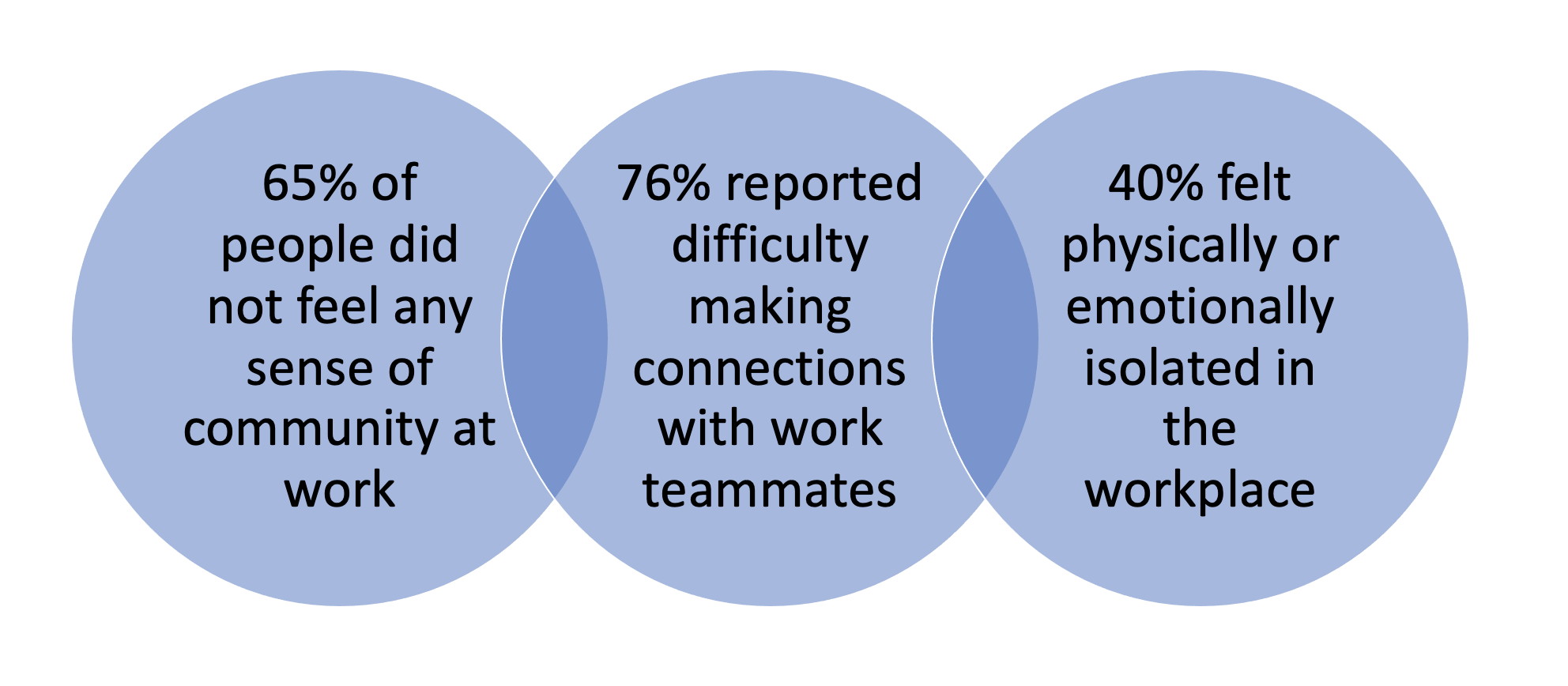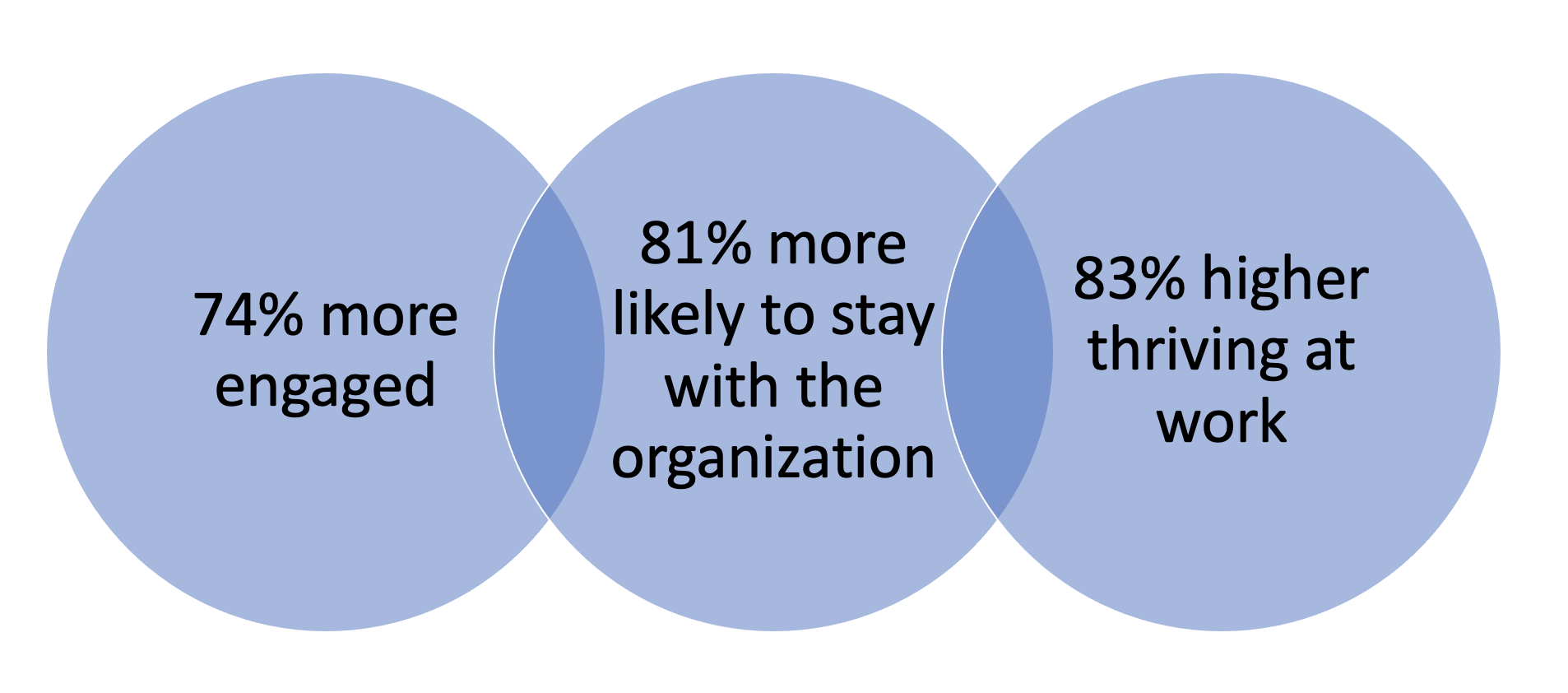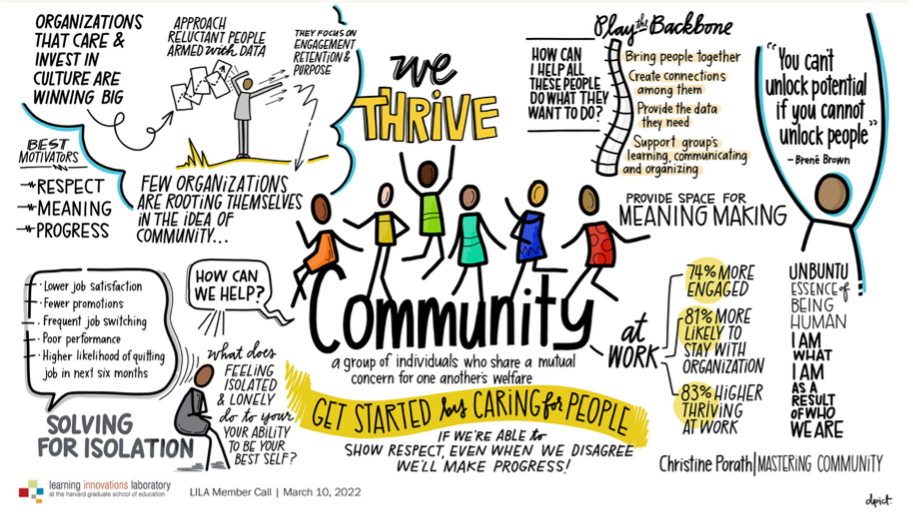Summary of LILA Member Call with Christine Porath: Mastering Community
March 2022
Notes by Mirielle Eaton and Ruby Huang
Guest Faculty
Christine Porath is professor at Georgetown University’s McDonough School of Business. She’s the author of Mastering Civility: A Manifesto for the Workplace and co-author of The Cost of Bad Behavior.
Introduction
Christine defines community as “a group of individuals who share a mutual concern for one another’s welfare”. This definition speaks to the difference it makes when you feel that sense of being a part of something. It describes the feeling of “I care about people, they care about me, and they have by back.” We will be highlighting the benefits of when people feel that sense of caring.
The book was also inspired by a personal story for Christine. In 2008, her brother Mike and his wife got the horrible diagnosis that their daughter Anabelle had a rare chromosomal disorder, and on the same day they found out that the baby they were pregnant with was missing at least one or perhaps several organs. It was a devastating time for them, and because Anabelle’s disorder was rare, there was very little information available. As Mike searched Google for answers, he came across some old PDF documents which turned out to written by parents and families telling their own stories about coping with similar diagnostics, which turned out to be invaluable for Mike and his wife. As the family struggled through feelings of isolation and searching for information, they imagined creating a community where patients, researchers, caregivers, and others could come together to address both the medical and the social-emotional support that is needed to tackle these complex situations. That is how Mike and his wife built “The Mighty”, a platform that now has several million people engaged. They were solving for isolation.
Why this book, why now?
Christine and her colleague Tony Schwartz studied the question “What stands in the way of being more satisfied and productive at work?”. They found that even before the pandemic,
 The research showed that a lot of what was at the root of even larger health problems was that people were feeling isolated and lonely. Lonelier workers are less satisfied, enjoy fewer promotions, switch jobs more often, are more likely to quit in the next 6 months, and have they lower performance. In contrast, when people feel a sense of community at work:
The research showed that a lot of what was at the root of even larger health problems was that people were feeling isolated and lonely. Lonelier workers are less satisfied, enjoy fewer promotions, switch jobs more often, are more likely to quit in the next 6 months, and have they lower performance. In contrast, when people feel a sense of community at work:

Giving these statistics, what surprised Christine was that so few organizations are rooting themselves in connection and community. They underestimate the value of community and instead focus on purpose and retention. Christine’s hope with this research and book is that more organizations will form community-first businesses.
Drawing from research findings, Christine named some potential wins of improving people’s sense of thriving, including 16% better performance (managerial ratings of people), 32% higher commitment, 1.3 times lower burnout, and 61% better health.
Findings
What makes people thrive, and what makes them feel connected and engaged? Christine has surveyed hundreds of thousands of people and concludes that to help people thrive, we should focus on these levers: (1) unite, (2) unleash, (3) respect, (4) radical candor, and (5) provide meaning.
Unite
Uniting involves creating a psychologically safe environment where people feel like they belong. It is the creation of a safe space of transparency and trust. Uniting also means providing connection and support, caring, and sharing. Some big parts of uniting are communicating resources (e.g., Cisco providing mental health support) and embracing failure. Google did a study that asked what drives team effectiveness and the results were not what they expected. They found that the number one thing was psychological safety (before dependability, structure and clarity, meaning, and impact) and that people who were on these teams drove more revenue, stayed longer, and had more personal results. Since psychological safety is such a key factor of success for an organization, what can leaders do to create psychological safety? Some related themes include (1) setting the stage (providing an environment where people can come together and feel unite even if they are different), (2) inviting participation (more details to come in the next topic: unleash), and (3) responding appreciatively (related to radical candor and feedback).
Unleash
This idea ties to one of our fundamental needs of autonomy. In order to unleash, leaders need to switch their mentalities from “How can I get all these people to do what I want?” to “How can I help all these people do what they want to do?”. To do this, leaders need to play a backbone role which includes bringing people together, creating connections among them, providing the data they need, and supporting groups in their learning, communicating, and organizing. They also need to provide room for groups to localize solutions, that is to say, to adapt them to the specificities of that group. In many cases, this means providing the framework or basic key elements, but allowing people to fill in the rest in a way that is relevant for them in their local contexts.
Respect
When asked, the number one thing that people want from their leaders is respect. They list respect even above other important considerations such as opportunities for learning and development, recognition, and feedback. When people feel respected by their leaders, they are more engaged and healthier. In contrast, when they feel disrespected, there is a 66% decrease in effort, 80% lost time worrying, and 12% staff attrition. Feeling respected is crucial to feeling a sense of belonging, connection, and psychological safety. Incivility can spread in the networks and affect people’s emotions, motivations, and performance. But the good news is that civility spreads that way, too. Small things like saying “Thank you”, smiling, listening attentively, and making eye contact can make a big difference in people’s perception of respect.
Radical Candor
Radical candor starts with leaders showing they care personally. This allows them to set the stage to give feedback. When employees receive feedback from someone who personally cares about them, they are less likely to get defensive and more likely to act on the feedback, which can eventually drive things like innovation and performance. This aligns with Kim Scott’s idea of “You care personally, then you can challenge directly.” Radical candor and recognition together help people to become their best selves. Connecting people this way can also lead to collaboration, performance, creativity, better relationship, etc. In contrast, ruinous empathy, an environment where people avoid giving critical feedback because they don’t want to hurt others’ feelings, can be problematic. Christa Quarles, CEO of OpenTable, gave a personal example to argue that although it can be awkward to give negative feedback, they could actually teach you a lot and you will learn more quickly and come up with better solutions.
Provide meaning
American employees say that meaning is the number one priority in their jobs and the number one driver of thriving at work. Leaders can contribute to providing meaning through several methods, one of which is storytelling. Stories can be about within or outside of the organization, such as the case of customers, patients, or other people who benefitted from the work of the organization. These stories should be told in meaningful ways that make people feel proud of where they work, and that leads to better engagement and better results. The other way to provide meaning at work is to bolster wellbeing. Wellbeing can be boosted through connection and caring, as well as creating shared experiences. It leads to increases in performance and engagement, less emotional exhaustion, less absenteeism, better teamwork, and higher levels of satisfaction.
Increasing a Sense of Community
Christine shared several examples of how leaders create a sense of community. Among these, two leaders achieved significant results in the context of increasing the sense of community for their people.
Phil Jackson
Phil Jackson was the coach for the Chicago Bulls. He had significant experience coaching on tribal native American land and wanted to set the stage for his team to feel like a tribe. To do so, he designated a room, adorned with tribal artifacts, just to gather, talk, and have conversations. As the coach, he demonstrated being vulnerable and opened the space to encourage others to be vulnerable. There are unique things he did, such as learning about the tribes, assigning different readings and talking about the topics together (e.g., ethics and other ones that had nothing to do with sports). In this context, team members were cheering and crying for each other, and they went on to win 6 NBA championships. This is a great embodiment of what Brené Brown said, “You can’t unlock potential if you cannot unlock people.”
Doug Conant
Doug Conant, author of The Blueprint: 6 Practical Steps to Lift Your Leadership to New Heights and former CEO of Campbells Soup. When he took over as CEO, the company was not doing well. In fact, Gallup said they were the least engaged organization that Gallup had ever measured. Doug Conant went about turning this around and saying that he would be tough on standards and tender hearted on people. To achieve this, he focused on touchpoints, which were brief points during the day where he would simply talk to people anywhere – in the organization, in the hallways, or in the cafeteria. He would listen and give them his undivided attention and he would end the touchpoint asking “how can I help?”, which was what made all the difference.
Christine explained that in order to make such changes one is looking for, the idea of self-awareness is key. Tasha Eurich found that 95% of the people think they’re self-aware, but only 10-15% of them really are. We can hone in on our blind spots by gathering feedback, working with coach, having conversations with the team, and taking care of ourselves. She summarized part 2 of the book by saying that leaders should not only encourage the best but also role-model it to drive the desired outcomes.
Finally, Christine closed with the concept of finding Ubuntu. That is, finding a sense of connection and belonging to others. You can’t exist as a human being in isolation. Ubuntu speaks about our interconnectedness. I am who I am because of who we all are. It is a game-changing philosophy in our work environments.
Questions and Answers
Question: You identified 6 different elements that contribute to community, but they are all interconnected with each other and we can’t really have community without having all of them. Are there some that will impact the others and make the others more possible if we lay a foundation through them?
Answer: A lot of this boils down to caring for people. Working on respect is really a connection point for all of them. If you care, you can have radical candor, and then you can unite. By focusing on a commonality, that gets the ball rolling. If I had to choose one, it would be the global idea of caring and then respect, which ties together a lot of these themes.
Question: Do civility and incivility spread at the same rate?
Answer: I don’t think so. The bad is stronger than good (across many different studies). In my work, we studied energizers and de-energizers at work. De-energizers have 4 to 7 times the effect as energizers.
Question: Can you speak to the difference between providing meaning and allowing the space for meaning making? Is one more valuable than the other?
Answer: Giving the space to make meaning is the most important. You allow people to create that for themselves. This can include some basics like “How do you structure your day?”, “How are you going to structure people you are working with?”, etc. It means letting people spend time and energy in ways that lead them to thrive (which can also be outside of the workplace). We bring a stronger, more resilient self in when we feel we are thriving outside of work – that is important. Providing meaning will get you a long way but given the future of work providing the space is seen as empathetic leadership and it’s fantastic.
Question: I’m working with some people who have different identities from my own, notably BiPOC and Indigenous people, and they are very sensitive to the topic of appropriation. They say that their culture is being appropriated by and for the privilege of white people. How can I reconcile listening and respecting what these people are saying?
Answer: You can, for example, have a group of people to collect and deal with complaints and engage in dialogue. Taking what you are learning and sharing it with others. For example, asking “What is at the root of this and what can we do better? Do you have suggestions?” It’s hard to get it right all the time, but we can all learn from this and move forward together.
Question: How might people be able to sense progress as they’re building community? Some people might have a vision and know what they are trying to get to, but others might be new to this. How can we help leaders to understand and feel the progress they are making?
Answer: One thing you can do is use pulse data, anything that will help you to track progress. Progress is the number one motivator in people’s daily work. You can use your pulse data strategically to figure out how you can get better in a constant evolution. Another example is Cisco, they had a feedback program called “Love and Loathe”. They survey people weekly about what is the one thing they love and loathe during the week. This helps keep a pulse on how people are feeling and what needs to be addressed. You can use the feedback to just relate and connect with people. How do you know then if there is progress? Track the well-being scores and hopefully, with some specifics, try to address it. I hope we can move from engagement to some of the deeper things around respect, community, belonging, inclusiveness, etc.
Question: I’ve come across leaders who say that it’s not my job to care but to get the job done. Any insights or advice when you run into these types of leaders?
Answer: I like to come at people with some data and how it matters and how caring pays. A strong example is what Tom Gardner talked about in a Google re:Work conference – companies that invest in and care about culture have better results. You need to find examples that speak to what those leaders care about. For example, if it’s the financials and performance outcomes that those leaders care about, then you can show them that how people feel is going to drive the performance they are looking for. You can start at a high level (e.g., examples from books of inspiring leaders), and then come down to specific successful stories that are valuable in your context.
Question: I’m inspired by the idea of being the “backbone”. Are there things people have done that’s, instead of being leader-led, more like communities of practice or something that helps create the community?
Answer: An example is the “take care” ambassadors at Marriot, where people are really free to come up with various ideas on what is important, relevant, and meaningful to them to take care of themselves and the community. Another example is the 100,000 Homes Campaign, where people were given a lot of liberty. Deloitte also has a lot of localized solutions and resources for mental health, wellbeing, and so forth, which are self-led by the teams.
List of people and organizations mentioned by Christine
| Name | Topic |
| Bob Sutton Stanford Graduate School of Business | the negatives (toxicity, rudeness, etc.) and bright spots of organizations |
| Tony Schwartz | survey on work/life balance and sense of community |
| Brené Brown | unlocking people |
| Kim Scott | radical candor |
| Christa Quarles CEO of OpenTable | ruinous empathy |
| Tasha Eurich | self-awareness |
| Amy Wrzesniewski Yale School of Management | creating meaning |
| Tom Gardner co-founder and CEO of Motley Fool | creating meaning and engagement |
| Teresa Amabile | progress as motivator at work |
| David Rodriguez | inclusiveness and belonging |
| Cisco https://www.cisco.com/ | conscious culture, diverse and inclusive environment, love/loathe |
| The Mighty https://themighty.com/ | healthcare community |
| Marriott www.marriott.com | take-care program |
| The Motley Fool https://www.fool.com/ | caring |
| The 100,000 Homes Campaign http://www.100khomes.org/ | unleashing people |

